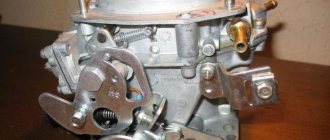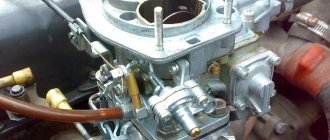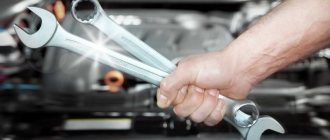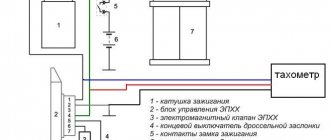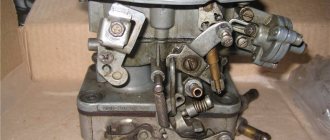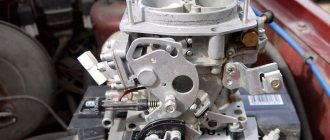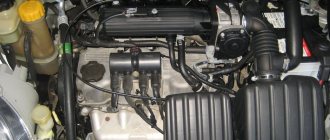Published:
06.12.2016
Adjustment of VAZ-2108 Solex carburetors can be carried out independently by motorists. After successfully installing the carburetor on the engine, you need to configure it for the power unit to guarantee stable operation of the device. Despite the fact that initially numerous doubts arise regarding how to correctly carry out the setup procedure, you can successfully cope with the task.
Owners of a VAZ 2108 will sooner or later be faced with the need to adjust the carburetor
Level determination in float chambers
In each case, the adjustment begins with setting the appropriate level in the float chambers. Not everything is configured from the factory, so you need to take care of completing the task yourself.
The driver must set the gasoline level correctly:
- At the first stage, it is recommended to start the engine and let it run. Most often it takes about five minutes. At this time, you are allowed to gently throttle, because otherwise the extra effort will lead to shooting at the carburetor or exhaust pipe.
- After the engine starts running, it is recommended to carefully turn it off.
- The next step is to carefully remove the fuel supply hose. You need to act carefully, as gasoline may splash out of the structure. If this task is not completed, correct readings will not be achieved. Only if you successfully remove the carburetor cap will fuel flow under pressure into the chamber. Otherwise, no changes will be recorded and the help of specialists will be required.
- The next task is to unscrew the 5 screws that attach the carburetor cover. Now you can remove the choke cable.
- The carburetor cover may be removed. It must be kept in a horizontal position. Whether the floats can be kept intact and operational largely depends on the correctness of these actions.
- It is recommended to measure the distance. For correct measurements, use a caliper. If it is missing, a ruler is recommended. The distance should be between 23 and 25 millimeters in both chambers. In any case, the indicators in the chambers used will differ slightly from each other, because the collector is not located horizontally. In order to assess the correctness of the indicator, it is recommended to find out the average value. If deviations are detected, the tongue is carefully bent in the desired direction, after which the gasoline is partially poured out. Only after all indicators meet the established standards is it possible to assemble the camera in the reverse order.
- The final stage of the test is starting the engine. At this time, it is important to look into the carburetor chambers. In order to see everything, you will need a powerful flashlight. It is advisable to watch for at least 30 seconds. During this time, not a single drop of used fuel should fall. If gasoline drips from the diffusers, an overflow may be suspected. After everything, the gasoline level in the chamber is re-measured.
The engine cannot be fully started. Otherwise, there is a risk of overflow when the engine is running. It is important to understand that adjusting the floats of the VAZ-2108 Solex carburetor is only the first and important stage of engine tuning.
Applicability and modifications of the 2108 Solex carburetor
Malfunctions, adjustments, tuning and repairs of various models have much in common. This is due to the fact that the operating principle of carburetor systems, devices and mechanisms is basically the same. The differences are due to the design features of some modifications. Below is a list of the main modifications of the Solex carburetor.
Applicability and modifications of the Solex carburetor
DAAZ 2108-1107010 is the base carburetor for the entire family, installed on cars 2108, 2109 with a 1.3 liter engine.
DAAZ-21081-1107010 was installed on 1.1 liter engines of VAZ-21081, 21091, ZAZ-1102 “Tavria” cars.
DAAZ-21083-1107010 was installed on 1.5 liter engines of VAZ-21083, 21093, 21099 cars.
DAAZ-21083-1107010-31 was installed on cars 2108, 2109, 2110, 2111 with a 1.5 engine. Has a semi-automatic starting device.
DAAZ-21083-1107010-35 was installed on VAZ-2108, 2109 cars with a 1.5 engine. Identical to the previous one. The difference is in the two-stage semi-automatic starting device; it is two-stage (winter-summer).
DAAZ-21083-1107010-62 was installed on a VAZ-2109, 2115 car with a 1.5 engine. Has electronic control of the fuel mixture composition.
DAAZ-21083-1107010-05 was installed on VAZ-2109 cars with a 1.5 engine and a microprocessor ignition system.
DAAZ-21412-1107010, DAAZ-21412-1107010-30 were installed on AZLK-2141-01 and AZLK-2141-23 vehicles with UAZAM-331 (1.5 liters) and UAZAM-3313 (1.8 liters) engines. They do not have a fuel drain fitting and the second carburetor is adapted for a microprocessor ignition system.
DAAZ-1111-1107010 was installed on the VAZ-1111 (0.65 liter) and VAZ-11113 (0.75 liter) engines of the VAZ-1111, VAZ-11113 “Oka” cars. Structurally, it has quite large differences with the basic carburetor 2108 (float chamber, economizer, throttle valve drive).
For rear-wheel drive models of VAZ cars, several modifications of the 2108 carburetor were produced. They have a similar structure, but have a traction drive of the throttle valves and no return flow of fuel into the gas tank.
DAAZ-21051-1107010 was installed on the VAZ-2103 engine (1.5 liters) of the VAZ-2105 car and the VAZ-21011 engine (1.3 liters) of the VAZ-21072 car.
DAAZ-21053-1107010 was installed on the VAZ-21074 engine (1.6 liters) of the VAZ-2107 car and a similar engine of the VAZ-21061 car.
DAAZ-21051-1107010-30 was supplied as a spare part for the VAZ-2105 engine (1.3 liters) of VAZ-2104 and VAZ-2105 cars.
DAAZ-21053-110701-62 was installed on VAZ engines of 1.5, 1.3, and 1.6 volumes of VAZ-2107, VAZ-21072, VAZ-21074. The carburetor of this model has a semi-automatic air damper drive.
DAAZ-21073-1107010 was installed on VAZ engines of 1.6 and 1.7 liters of all-wheel drive vehicles VAZ-2121, VAZ-21213 Niva. The carburetor has only one accelerator pump nozzle in the first chamber.
It should be noted that almost all modifications of the 2108 Solex carburetor have different calibration data from each other.
Notes and additions
— The applicability of Solex carburetors on various car models (not only VAZ) is tabulated on the page “Table of applicability of Solex carburetors on different car models.”
Source
Idle speed setting
After correctly setting the gasoline level, it is recommended to warm up the engine to operating temperature. Then the engine is turned off and the idle speed is set. A properly tuned engine should successfully exhibit its optimal performance characteristics.
Instructions:
- Using a flat-shaped screwdriver, you need to feel the mixture quality screw located in the carburetor base.
- The screw is turned clockwise until it stops. You cannot use force. Otherwise, the thread will be torn off.
- From the achieved position you need to make 5-6 revolutions back.
- The engine needs to be started, after which the suction is eliminated. The screw sets the minimum speed, taking into account the fact that the motor must operate stably. The minimum vacuum must be set in the fitting. Optimal speed indicators are 500–1200. If the indicator fits within the specified limits, the carburetor has been corrected and adjusted, making it ready for full operation.
- Now you need to tighten the screw. The main indicator of the achieved result is the beginning of unstable operation of the motor. For stable operation of the engine you will have to make 1–1.5 revolutions back. It is advisable to perform such actions slowly. If you rush, you will not be able to achieve good results.
- You need to set the speed with the screw to about 850–900. Most often, these characteristics are successfully perceived by the VAZ, allowing you to count on a decent ride in the car. If any deviations are noted, you need to unscrew the screw a little and ensure that the standard indicators are corrected.
- Points 5 and 6 are repeated until the optimal ratio for stable engine operation and minimum vacuum in the car tube can be found.
Setting up jets
The jets may only be adjusted based on how they are supposed to work. Otherwise, actions will not bring the desired result. The engine jet is required for the successful passage of air flow through the diffuser opening. The large volume of the power unit will lead to successful air intake by the motor. In carburetors that are designed for large engines, it is customary to install small jets. The conformity of all installed jets is a mandatory requirement. Correctly installed jets guarantee successful operation of the VAZ-2108 Solex engine.
A little history
With the start of production of cars from the Volga Automobile Plant, engines of this brand began to be equipped with Ozone carburetors and their two-chamber “twins” Weber, which were well combined with longitudinally located power units on classic VAZs. However, in the mid-80s, the appearance of the front-wheel drive “Eight” forced the plant’s designers to look for a new carburetor option. Ozones and Webers were not suitable for a transversely mounted motor. In addition, the old models no longer met the increased requirements for efficiency and environmental safety.
The unit of the French company Solex was taken as the basis. The creatively modified prototype of the “Frenchman” received the Russian name “Solex-2108”. This carburetor model is still produced by the domestic auto industry. The design solutions used in the development of this carburetor model turned out to be so successful that Solex is still produced by the domestic auto industry.
Acceleration pump
The accelerator pump determines how much gasoline will be consumed when driving the car. In addition, the optimal acceleration parameters of the vehicle are determined.
To start its operation, use a cam, which is part of the accelerator pump. For the UZAM engine, the accelerator pump cam must have the largest dimensions.
The flow of fuel used must be smooth. Otherwise, you may suspect serious problems with the working accelerator pump. The appearance of a tiny trickle or small drops casts doubt on the stable operation of the equipment.
A mandatory requirement is correct adjustment of the position of the spout. Gasoline must go through the following path:
- opening between the diffuser and the installed throttle valve;
- direction to the collector.
If gasoline spills onto the damper or diffuser, there is a risk that the car will not be able to show its optimal parameters when starting the engine.
The correct operation of the accelerator nozzle must be monitored, since it determines whether the Solex carburetor can operate successfully.
Transition mode
Opening the throttle valves is not allowed even at idle engine speed. A significant vacuum is always created under them for the successful release of gasoline and starting the engine. A sharp opening leads to a sharp drop in vacuum, but it turns out to be too weak for the main system of the first chamber to work successfully. The idle system and the functionality of the accelerator pump are no longer sufficient for the successful and stable operation of the carburetor. This leads to failure. A transition system is required to eliminate the resulting failure. When you press the gas, the hole can go into an area of strong vacuum, as a result of which gasoline consumption increases. This hole can also receive fuel through a jet.
Before understanding how to adjust the transition mode for successful riding, it is recommended to understand potential problems. Motorists often complain about the following problems:
- engine failure at start;
- dullness of the engine when starting to drive the car;
- the engine may simply sneeze, shoot and even stall.
The transition regime leads to similar violations. To eliminate various troubles, it is recommended to choose the most suitable location for the accelerator pump spout and nozzle. The engine must receive the optimal volume of high-quality mixture. Otherwise, he may choke.
Successful start-up of the engine is only possible if the correct transient settings are made. From the very beginning, the engine should pick up speed without delay and reach the desired value.
Broken ratios of indicators lead to disruption of engine operation. In this case, you need to adjust until the acceleration occurs according to the correct pattern.
If, despite all the actions taken, there are serious problems with speed gain and the engine can only run jerkily, shake and hum, the jets of the first chamber are not configured correctly.
The most tedious situation is to sort through the carburetor jets and the accelerator pump nozzle. This is done before setting the car to start correctly. Additionally, the motorist adjusts the idle speed, since the jet affects the idle speed.
Important points
- Before adjusting the carburetor, it is recommended to self-clean it. To do this, a special liquid for cleaning carburetors is poured into the gas tank, the engine starts and runs (the volume of liquid poured and the engine operating time are always indicated on the container with the cleaning liquid and depend on the specific brand). Sometimes this measure is enough to get rid of the above signs of carburetor malfunction and do without fine adjustments.
- If self-cleaning does not help, there is only one way out: you need to remove and wash the carburetor. For washing, both special liquids and ordinary kerosene are used. It is strictly not recommended to use brushes or fluffy rags to remove dirt. Hairs and lint remaining in the small holes of the carburetor can negate all efforts to clean it. The best option: thorough rinsing in a special liquid, and then blowing out all small holes with compressed air.
- Before removing the carburetor and cleaning the inside, it is recommended that the outside be thoroughly cleaned. Moreover, it is necessary to clean not only the carburetor itself, but also all the parts located next to it. Please be aware that any dirt left on adjacent parts may find its way into the clean carburetor when it is installed back into the engine. And if this happens, the entire cleaning procedure will have to start again.
In order for the carburetor to work correctly, attention should be paid not only to its adjustment, but also to cleaning. If any of these procedures are neglected, the carburetor will soon fail again. In addition, attention should be paid not only to the quality of gasoline, but also to the condition of the car’s air filter, since in some cases it is a worn filter that causes rapid contamination of the carburetor.
This is interesting: Mercedes-Benz will create a “talking” car
Copywriter with five years of experience. (1 vote, average: 5 out of 5)
Things to remember
The second chamber should not change its characteristics in any way when adjusting the carburetor. Most often, it is enough to correctly configure the factory jets. To compensate for the lack of jets and the first chamber, an econostat is used. What is its essence? The econostat allows you to guarantee complete vacuum when additional gasoline is successfully sucked out. This scheme is required at high speeds to improve the fuel composition. If you want perfect characteristics, you need to install improved jets with selection according to the first scheme.
Motorists should remember: adjusting the VAZ-2108 carburetor determines the functionality of the car.
If the article was useful, write to us.
How to properly configure a VAZ-2109 carburetor
The majority of VAZ cars of the Samara family, and in particular the VAZ-2109, came off the assembly line with a carburetor power system, and only later a small series received injectors. The carburetor system has a simple design and is quite reliable, but its main component, the carburetor, requires periodic adjustment. The VAZ-2109 and other models of the family were equipped with Solex carburetors, characterized by a relatively simple adjustment technology that every car enthusiast can perform.
There are two main carburetor settings - the fuel level in the float chambers and the engine speed at idle (idle). These adjustments are carried out when the engine is unstable at idle and when certain symptoms of improper operation of the power system appear:
- The engine does not start well.
- The dynamics of speed gain have decreased.
- Dips appeared during intensive acceleration.
These problems indicate that the fuel level in the chamber is not normal.
